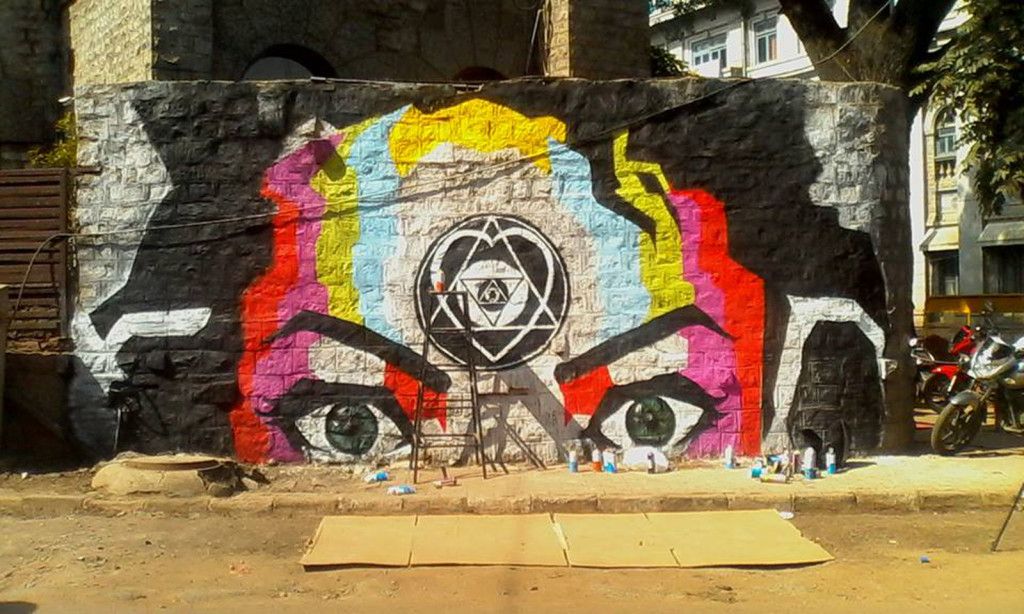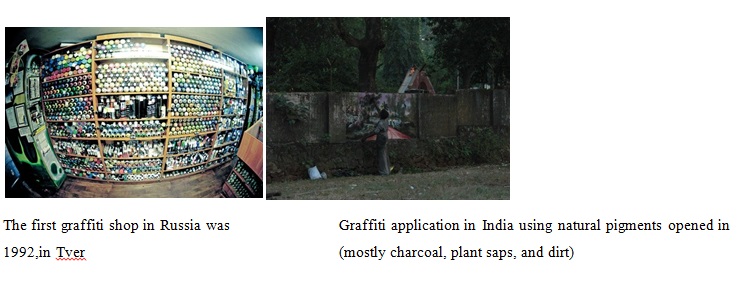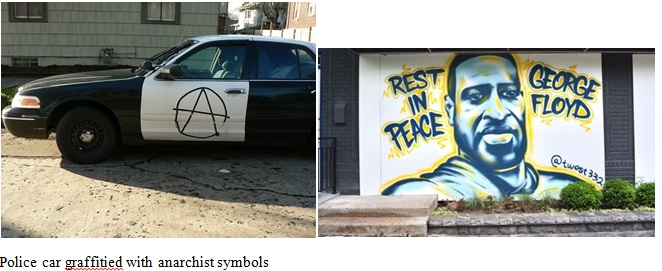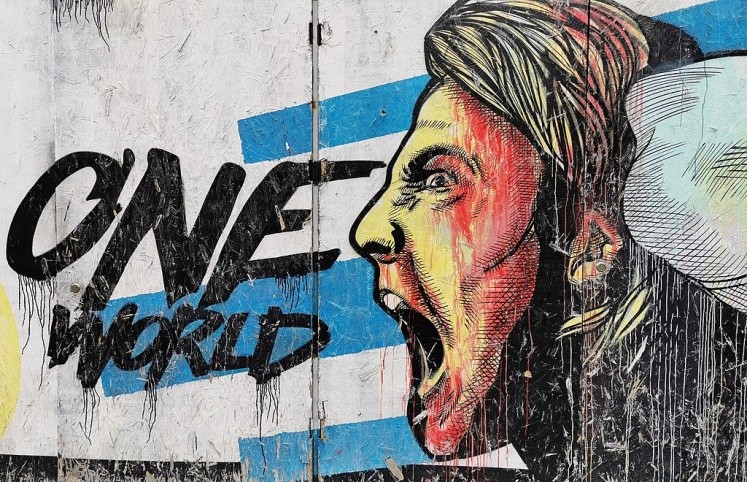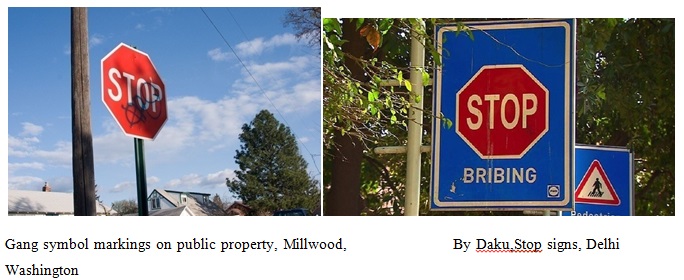Kritika Verma
I knew little about street art or traditional Graffiti when I began working on this thesis. I needed to immerse myself in the street art scene to understand it from an insider’s perspective. This method helped me better understand the relationships between individuals, art, and public spaces. I began communicating with street artists via the Internet. I attended several local street art-inspired gallery shows. I took photographs of all the street art that I encountered. One of the most beneficial aspects of this background research was informally observing city areas that contained street art concentrations. I wanted to understand how these spaces were used and how they might be unique from other spaces in the city.
Graffiti through the Ages
Graffiti (singular and plural; the particular graffito is rarely used except in archaeology) is a type of art genre that means writing or drawings made on a wall or other surface, usually without permission and within public view. Graffiti ranges from simple written words to elaborate wall paintings and has existed since ancient times, with examples dating back to ancient Egypt, ancient Greece, and the Roman Empire.
To Read Introduction of Graffiti Art in India: Street Art and Graffiti In Indian Public Spaces
Graffiti is a controversial subject. In most countries, property owners and civic authorities consider marking or painting property without permission as defacement and vandalism, a punishable crime, citing Graffiti by street gangs to mark territory or indicate gang-related activities. Graffiti has become visualised as a growing urban “problem” for many cities in industrialised nations, spreading from the New York City subway system in the early 1970s to the rest of the United States and Europe and other world regions. Graffiti is a controversial subject. In most countries, property owners and civic authorities consider marking or painting property without permission as defacement and vandalism, a punishable crime, citing Graffiti by street gangs to mark territory or indicate gang-related activities. Graffiti has become visualised as a growing urban “problem” for many cities in industrialised nations, spreading from the New York City subway system in the early 1970s to the rest of the United States and Europe and other world regions.
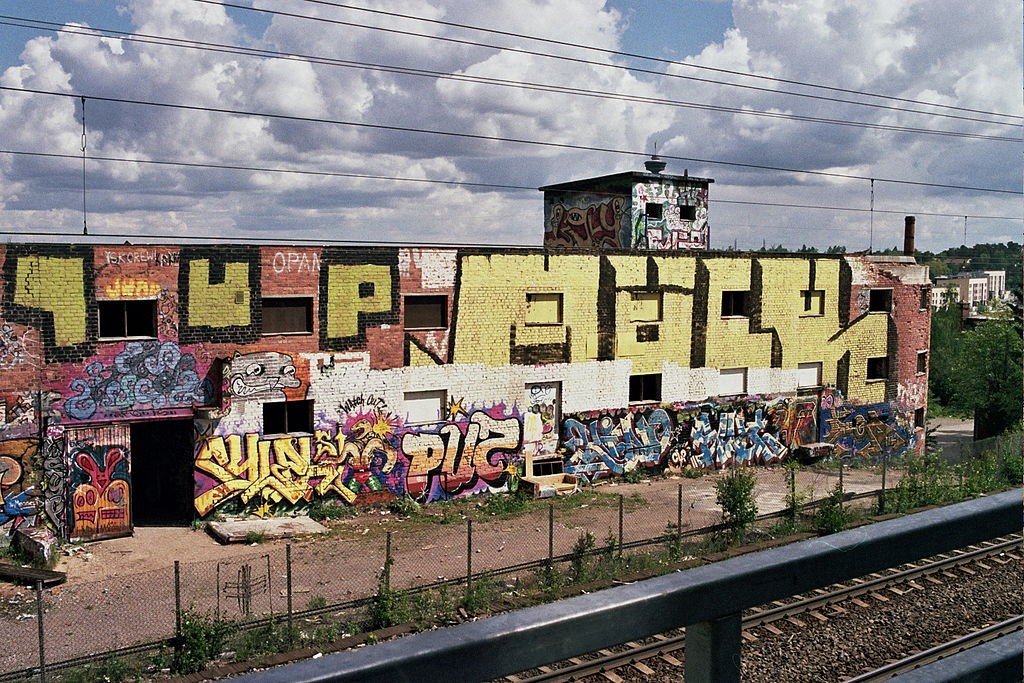
“Graffiti” (usually both singular and plural) and the rare, particular form “graffito” are from the Italian word Graffiato (“scratched”). “graffiti” is used in art history for works produced by scratching a design into a surface. A related term is “sgraffito”, which involves scratching through one layer of pigment to reveal another beneath it. This technique was primarily used by potters who glaze their wares and then scratch a design. In ancient times graffiti was carved on walls with a sharp object, although sometimes chalk or coal was used. The word originates from Greek γράφειν—graphein—meaning “to write”.
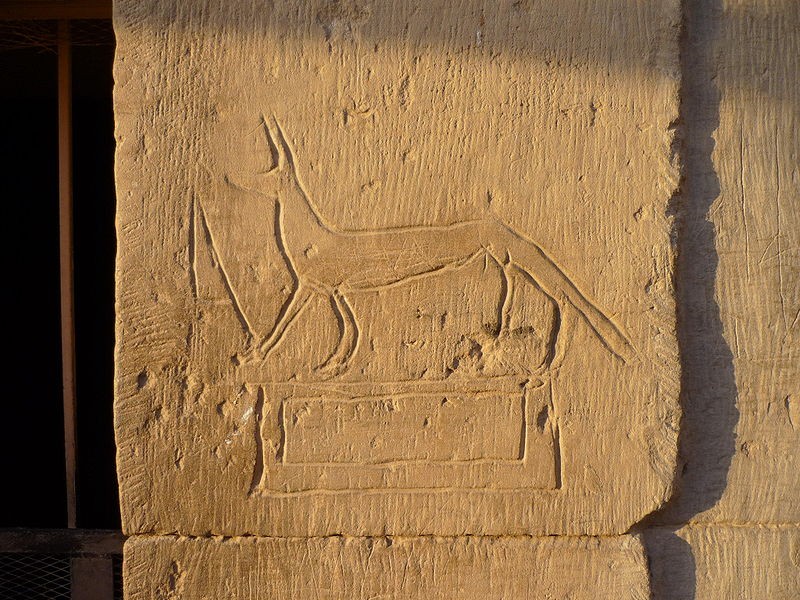
Graffiti originally referred to the inscriptions, figure drawings, and such found on the walls of ancient sepulchres or ruins, as in the Catacombs of Rome or at Pompeii. The use of the word has evolved to include any graphics applied to surfaces in a manner that constitutes vandalism.10 The only known source of the Safaitic language, an ancient Arabic, is from Graffiti: inscriptions scratched onto the surface of rocks and boulders in the predominantly basalt desert of southern Syria, eastern Jordan and northern Saudi Arabia. Safaitic dates from the first century B.C. to the fourth century AD.
To Read Introduction of Graffiti Art in India: Street Art and Graffiti In Indian Public Spaces
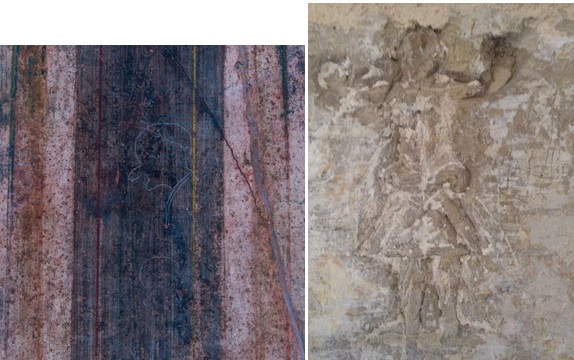
The first known example of “modern style” graffiti survives in the ancient Greek city of Ephesus (in modern-day Turkey). Local guides say it is an advertisement for prostitution; located near a mosaic and stone walkway, the Graffiti shows a handprint that vaguely resembles a heart, a footprint, a number, and a carved image of a woman’s head.
The ancient Romans carved Graffiti on walls and monuments, examples of which also survive in Egypt. Graffiti in the classical world had different connotations than they carry in today’s society concerning content. Ancient Graffiti displayed phrases of love declarations, political rhetoric, and simple words of thought compared to today’s popular messages of social and political ideals. The eruption of Vesuvius preserved Pompeii’s Graffiti, including Latin curses, magic spells, declarations of love, insults, alphabets, political slogans, and famous literary quotes, providing insight into ancient Roman street life. One inscription gives the address of a woman named NovelliaPrimigenia of Nuceria, a prostitute, apparently of great beauty, whose services were much in demand. Another shows a phallus accompanied by the text, Mansuetatene (“handle with care”).
Ancient tourists visiting the 5th-century citadel at Sigiriya in Sri Lanka scribbled over 1800 individual graffiti there between the 6th and 18th centuries. Etched on the Mirror Wall’s surface, they contain prose, poetry, and commentary. Most of these visitors appear to have been from society’s elite: royalty, officials, professions, and clergy. There were also soldiers, archers, and even some metalworkers. The topics range from love to satire, curses, wit, and lament. Many demonstrate a high literacy level and a deep appreciation of art and poetry. Most of the Graffiti refers to the frescoes of semi-nude females found there. One reads:
Among the ancient political graffiti examples were Arab satirist poems. Yazid al-Himyari, an Umayyad Arab and Persian poet, was most known for writing his political poetry on the walls between Sajistan and Basra, manifesting an intense hatred towards the Umayyad regime and its borders, and people used to read and circulate them very widely.
Historical forms of Graffiti have helped me understand the lifestyles and languages of past cultures. Errors in spelling and grammar in this Graffiti offer insight into the degree of literacy in Roman times and provide clues on the pronunciation of spoken Latin. Examples are CIL IV: VettiumFirmum / aed[ilem] quactiliar[ii] [sic] rog[ant]. Here, “qu” is pronounced as “co”. The 83 pieces of Graffiti found at CIL IV, 4706-85 are evidence of the ability to read and write at levels of society where literacy might not be expected. The Graffiti appeared on a peristyle which was being remodelled at the time of the eruption of Vesuvius by the architect Crescens. The Graffiti was left by both the foreman and his workers. The brothel at CIL VII, 12, 18–20 contains more than 120 pieces of Graffiti, some of which were the work of the prostitutes and their clients. The gladiatorial academy at CIL IV, 4397 was scrawled with Graffiti left by the gladiator CeladusCrescens (Suspiriumpuellarum Celadusthraex: “Celadus the Thracian makes the girls sigh.”)
It was not only the Greeks and Romans who produced Graffiti: the Maya site of Tikal in Guatemala contains examples of ancient Maya graffiti. Viking graffiti survive in Rome and at Newgrange Mound in Ireland, and a Varangian scratched his name (Halvdan) in runes on a fence in the Hagia Sophia at Constantinople. These early forms of Graffiti have contributed to the understanding of lifestyles and languages of past cultures.
Graffiti, known as Tacherons, were frequently scratched on Romanesque Scandinavian church walls. When Renaissance artists such as Pinturicchio, Raphael, Michelangelo, Ghirlandaio, or Filippino Lippi descended into the ruins of Nero’s Domus Aurea, they carved or painted their names and returned to initiate the Grottesche style of decoration.
To Read Introduction of Graffiti Art in India: Street Art and Graffiti In Indian Public Spaces
There are also examples of Graffiti in American history, such as Independence Rock, a national landmark along the Oregon Trail. Later, French soldiers carved their names on monuments during the Napoleonic campaign of Egypt in the 1790s. Lord Byron survives on one of the columns of the Temple of Poseidon at Cape Sounion in Attica, Greece.
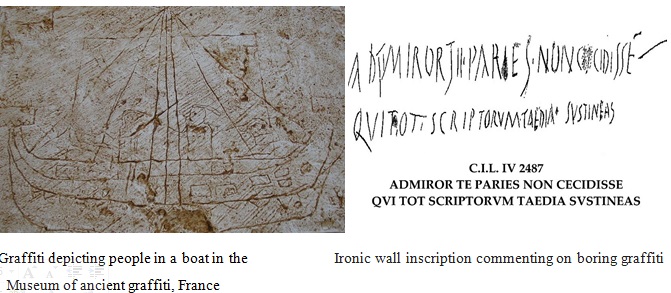 Contemporary graffiti style has been heavily influenced by hip-hop culture and the myriad international styles derived from Philadelphia and New York City Subway Graffiti. However, many other traditions of notable Graffiti in the twentieth century exist. Graffiti has long appeared on building walls, latrines, railroad boxcars, subways, and bridges.
Contemporary graffiti style has been heavily influenced by hip-hop culture and the myriad international styles derived from Philadelphia and New York City Subway Graffiti. However, many other traditions of notable Graffiti in the twentieth century exist. Graffiti has long appeared on building walls, latrines, railroad boxcars, subways, and bridges.
The oldest known example of modern Graffiti is the “monikers” found on train cars created by hobos and rail workers since the late 1800s. Filmmaker Bill Daniel documented the Bozo Texino monikers in his 2005 film, Who is Bozo Texino?
Some graffiti has its poignancy. In World War II, an inscription on a wall at the fortress of Verdun was seen as an illustration of the U.S. response twice in a generation to the wrongs of the Old World:
Austin White – Chicago, Ill – 1918 Austin White – Chicago, Ill – 1945
During World War II and for decades after, the phrase “Kilroy was here” with an accompanying illustration was widespread worldwide due to its use by American troops and ultimately filtering into American popular culture. Shortly after the death of Charlie Parker (nicknamed “Yardbird” or “Bird”), Graffiti began appearing around New York with the words “Bird Lives”. The student protests and general strike of May 1968 saw Paris bedecked in revolutionary, anarchistic, and situationist slogans such as L’ennuiestcontre- révolutionnaire (“Boredom is counterrevolutionary”) expressed in painted Graffiti, poster art, and stencil art. At the time in the U.S., other political phrases (such as “Free Huey” about Black Panther Huey Newton) became briefly popular as Graffiti in limited areas, only to be forgotten. A famous graffito of the early 1970s was “Dick Nixon Before He Dicks You”, reflecting the hostility of the youth culture to that U.S. president.
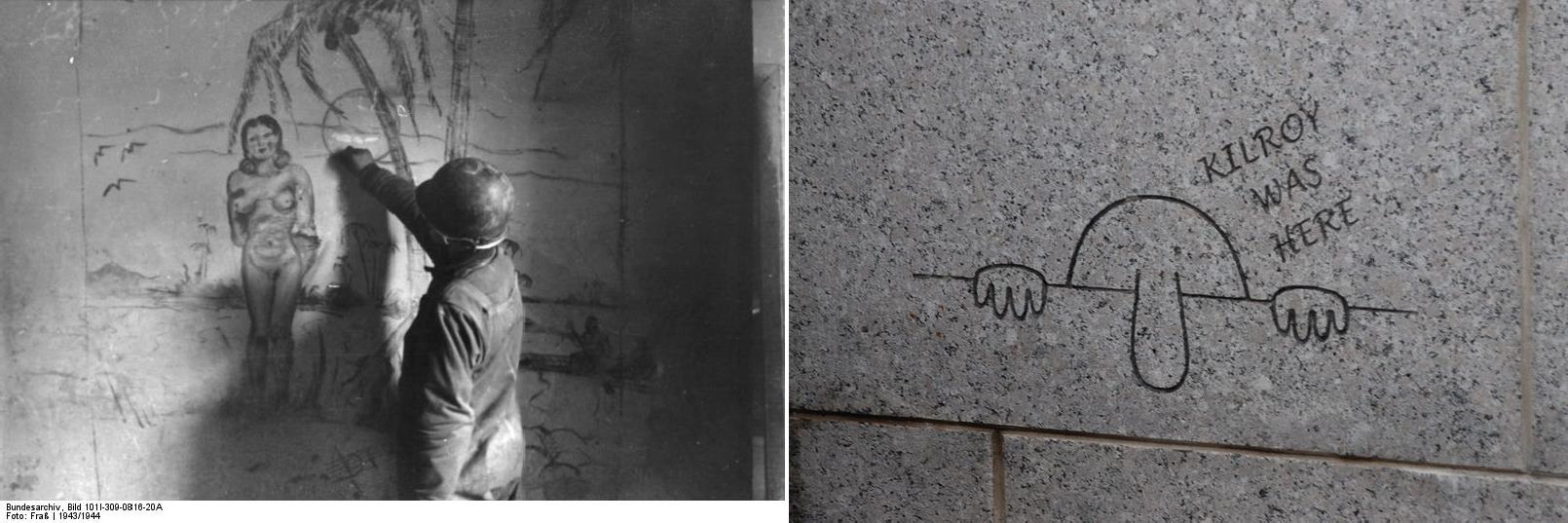
Rock and roll graffiti is a significant subgenre. A famous graffito of the twentieth century was the inscription in the London tube reading “Clapton is God” in a link to the guitarist Eric Clapton. The phrase was spray-painted by an admirer on a wall in an Islington station on the Underground in the autumn of 1967. The graffito was captured in a photograph where a dog urinated on the wall.
Graffiti also became associated with the anti-establishment punk rock movement in the 1970s. Bands such as Black Flag and Crass (and their followers) widely stencilled their names and logos, while many punk night clubs, squats, and hangouts are famous for Graffiti. In the late 1980s, the upside-down Martini glass that was the tag for the punk band Missing Foundation was the most ubiquitous graffito in lower Manhattan.
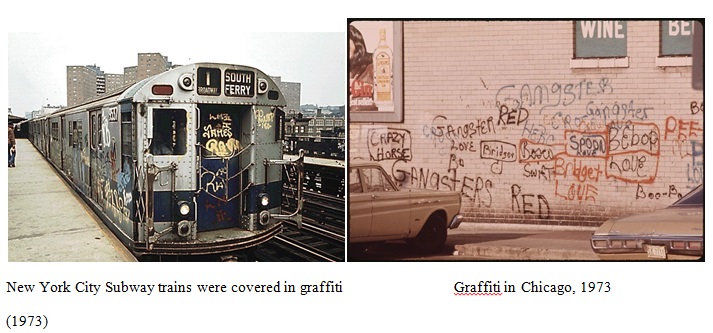 Style Wars depicted not only famous graffitists such as Skeme, Dondi, MinOne, and ZEPHYR but also reinforced Graffiti’s role within New York’s emerging hip-hop culture by incorporating famous early break-dancing groups such as Rock Steady Crew into the film and featuring rap in the soundtrack. Although many officers of the New York City Police Department found this film controversial, Style Wars is still recognised as the most prolific film representation of what was happening within the young hip-hop culture of the early 1980s. Fab 5 Freddy and Futura 2000 took hip-hop graffiti to Paris and London as part of the New York City Rap Tour 1983.
Style Wars depicted not only famous graffitists such as Skeme, Dondi, MinOne, and ZEPHYR but also reinforced Graffiti’s role within New York’s emerging hip-hop culture by incorporating famous early break-dancing groups such as Rock Steady Crew into the film and featuring rap in the soundtrack. Although many officers of the New York City Police Department found this film controversial, Style Wars is still recognised as the most prolific film representation of what was happening within the young hip-hop culture of the early 1980s. Fab 5 Freddy and Futura 2000 took hip-hop graffiti to Paris and London as part of the New York City Rap Tour 1983.
This period also saw the emergence of the new stencil graffiti genre. Some of the first examples were created in 1981 by graffitists Blek le Rat in Paris and 1982 by Jef Aerosol in Tours (France); by 1985, stencils had appeared in other cities, including New York City, Sydney, and Melbourne, where American photographer Charles Gatewood and Australian photographer Rennie Ellis.
With the popularity and legitimisation of Graffiti has come a level of commercialisation. In 2001, computer giant I.B.M. launched an advertising campaign in Chicago and San Francisco involving people spray painting a peace symbol, a heart, and a penguin (Linux mascot) on sidewalks to represent “Peace, Love, and Linux.” I.B.M. collectively paid Chicago and San Francisco US$120,000 for punitive damages and clean-up costs.
In 2005, a similar ad campaign was launched by Sony and executed by its advertising agency in New York, Chicago, Atlanta, Philadelphia, Los Angeles, and Miami to market its handheld PSP gaming system. In this campaign, taking notice of the legal problems of the I.B.M. campaign, Sony paid building owners for the rights to paint on their buildings “a collection of dizzy-eyed urban kids playing with the PSP as if it were a skateboard, a paddle, or a rocking horse”.
Characteristics of Graffiti
Modern-day graffitists can be found with an arsenal of various materials that allow for a successful piece production. This includes such techniques as scribing. However, spray paint in aerosol cans is the number one medium for Graffiti. From this commodity comes different styles, techniques, and abilities to form master graffiti works. Spray paint can be found at hardware and art stores and comes in virtually every colour.
Stencil graffiti is created by cutting out shapes and designs in a stiff material (such as cardboard or subject folders) to form an overall design or image. The stencil is placed on the “canvas” gently, and with quick, easy strokes of the aerosol can, the picture appears on the intended surface.
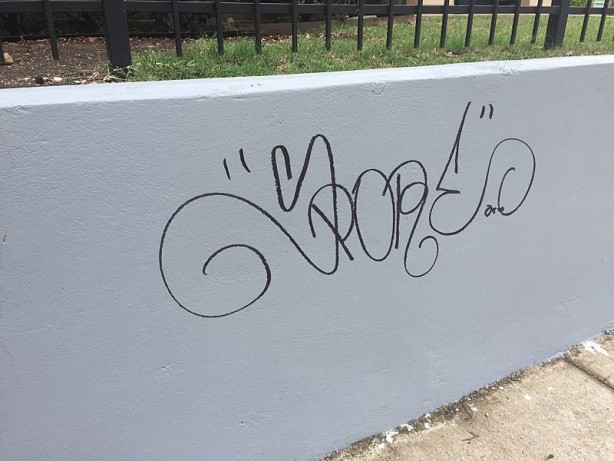
Theories on the use of Graffiti by avant-garde artists have a history dating back to Asger Jorn, who in 1962 declared in a graffiti-like gesture, “The avant-garde won’t give up”.
Many contemporary analysts and even art critics have begun to see artistic value in some graffiti and recognise it as a form of public art. According to many art researchers, particularly in the Netherlands and in Los Angeles, that type of public art is, in fact, an effective tool for social emancipation or the achievement of a political goal.
In times of conflict, such murals have offered communication and self-expression for members of these socially, ethnically, or racially divided communities. They have proven themselves as practical tools in establishing dialogue and, thus, addressing cleavages in the long run. The Berlin Wall was also extensively covered by Graffiti reflecting social pressures relating to the oppressive Soviet rule over the G.D.R.
Many artists involved with Graffiti are also concerned with similar stencilling activity. This entails stencilling a print of one or more colours using spray paint. Recognised while exhibiting and publishing several of her coloured stencils and paintings portraying the Sri Lankan Civil War and urban Britain in the early 2000s, graffitists MathangiArulpragasam, aka M.I.A., has also become known for integrating her imagery of political violence into her music videos for singles “Galang” and “Bucky Done Gun”, and her cover art. Stickers of her artwork also often appear around places such as London in Brick Lane, stuck to lamp posts and street signs; she has become a muse for other graffitists and painters worldwide in cities including Seville.
Personal expression
Many graffitists choose to protect their identities, remain anonymous, or hinder prosecution.
With the commercialisation of Graffiti (and hip hop in general), graffitists tend to choose anonymity in most cases, even with legally painted “graffiti” art. This may be attributed to various reasons or a combination of reasons. Graffiti remains one of four hip-hop elements that is not considered “performance art” despite the image of the “singing and dancing star” that sells hip-hop culture to the mainstream. Being a graphic form of art, many graffitists still fall into the category of the introverted archetypal artist.
Banksy is one of the world’s most notorious and famous street artists who continue to remain faceless in today’s society. He is known for his political, anti-war stencil art, mainly in Bristol, England, but his work may be seen anywhere from Los Angeles to Palestine. Banksy is the most recognisable icon in the U.K. for this cultural, artistic movement and keeps his identity a secret to avoid arrest. Much of Banksy’s artwork may be seen around the streets of London and surrounding suburbs. However, he has painted pictures worldwide, including the Middle East, where he has painted on Israel’s controversial West Bank barrier with satirical images of life on the other side. One depicted a hole in the wall with an idyllic beach, while another showed a mountain landscape on the other side. Several exhibitions have also taken place since 2000, and recent works of art have fetched vast sums of money. Banksy’s art is a prime example of the classic controversy: vandalism vs. art. Art supporters endorse his work distributed in urban areas as art pieces, and some councils, such as Bristol and Islington, have officially protected them. In contrast, officials of other sites have deemed his work vandalism and removed it.
Pixnit is another artist who keeps her identity from the general public. Her work focuses on Graffiti’s beauty and design aspects instead of Banksy’s anti-government shock value. Her paintings are often of flower designs above shops and stores in her local urban area of Cambridge, Massachusetts. Some store owners endorse her work and encourage others to do similar work. “One of the pieces was left up above Steve’s Kitchen because it looks pretty awesome”- Erin Scott, the manager of New England Comics in Allston, Massachusetts.
Graffiti artists may become offended if photographs of their art are published commercially without their permission. In March 2020, the Finnish graffiti artist Psyke expressed his displeasure at the newspaper Ilta-Sanomatpublishing a picture of a Peugeot 208 in an article about new cars, with his Graffiti prominently in the background. The artist claims he does not want his art used commercially, not even if he were to receive compensation.
Radical and Political
Graffiti often has a reputation as part of a subculture that rebels against authority. However, the considerations of the practitioners often diverge and can relate to a wide range of attitudes. It can express a political practice and form just one tool in various resistance techniques. One early example includes the anarcho-punk band Crass, who campaigned stencilling anti-war, anarchist, feminist, and anti-consumerist messages throughout the London Underground system during the late 1970s and early 1980s. In Amsterdam, Graffiti was a significant part of the punk scene. The city was covered with names such as “De Zoot”, “Vendex”, and “Dr Rat”. To document Graffiti, a punk magazine was started that was called Gallery Anus. So when hip-hop came to Europe in the early 1980s, there was already a vibrant graffiti culture.
The student protests and general strike of May 1968 saw Paris bedecked in revolutionary, anarchistic, and situationist slogans such as L’ennuiestcontre-révolutionnaire (“Boredom is counterrevolutionary”) and Lisezmoins, Vivez plus (“Read less, live more”). While not exhaustive, the Graffiti gave a sense of the ‘millenarian’ and rebellious spirit, tempered with a good deal of verbal wit, of the strikers.
I think graffiti writing is a way of defining what our generation is like. Excuse the French; we’re not a bunch of p———– artists. Traditionally artists have been considered soft and mellow, a little bit kooky. We may be a little bit more like pirates that way. We defend our territory; whatever space we steal to paint on, we protect it fiercely.
—Sandra “Lady Pink” Fabara.
The developments of graffiti art, which took place in art galleries and colleges as well as “on the street” or “underground”, contributed to the resurfacing in the 1990s of a far more overtly politicised art form in the subvertising, culture jamming, or tactical media movements. These movements or styles tend to classify the artists by their relationship to their social and economic contexts since, in most countries, graffiti art remains illegal in many forms except when using non-permanent paint.
Contemporary practitioners, accordingly, have varied and often conflicting practices. Some individuals, such as Alexander Brener, have used the medium to politicise other art forms and have used the prison sentences enforced on them to protest further. The practices of anonymous groups and individuals vary widely, and practitioners do not always agree with each other’s rules. For example, the anti-capitalist art group Space Hijackers did a piece in 2004 about the contradiction between the capitalistic elements of Banksy and his use of political imagery.
Berlin human rights activist Irmela Mensah-Schramm has received global media attention and numerous awards for her 35-year campaign of effacing neo-Nazi and other right-wing extremist graffiti throughout Germany, often by humorising hate speech.
Territorial Graffiti marks urban neighbourhoods with tags and logos to differentiate certain groups from others. These images are meant to show outsiders a stern look at whose turf is whose. The subject matter of gang-related Graffiti consists of cryptic symbols and initials strictly fashioned with unique calligraphies. Gang members use Graffiti to designate membership throughout the gang, differentiate rivals and associates, and, most commonly, mark territorial and ideological borders.
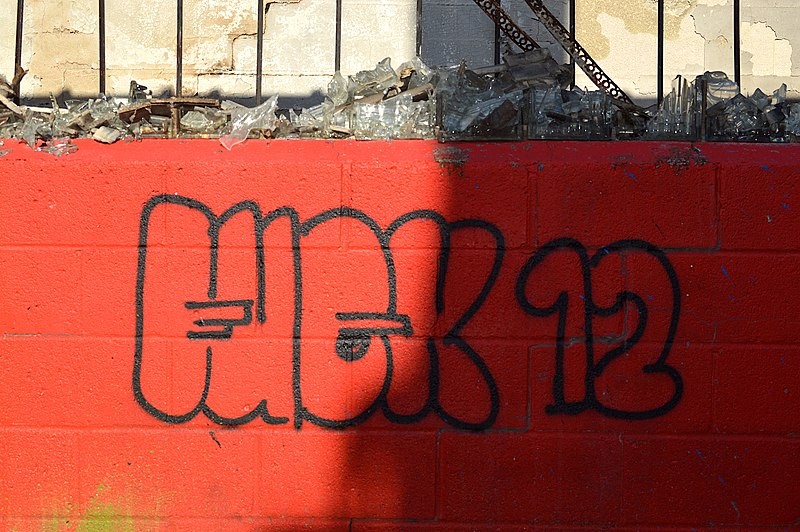
Political Graffiti around the World
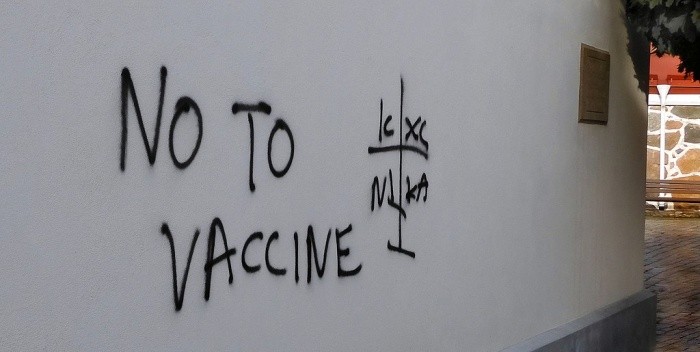
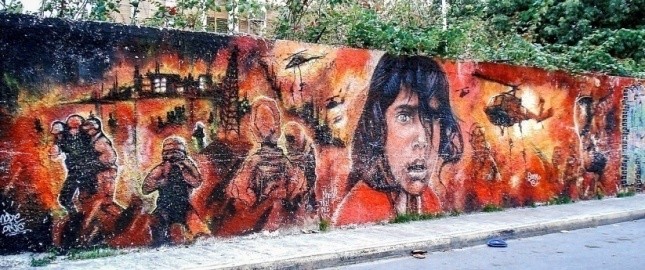
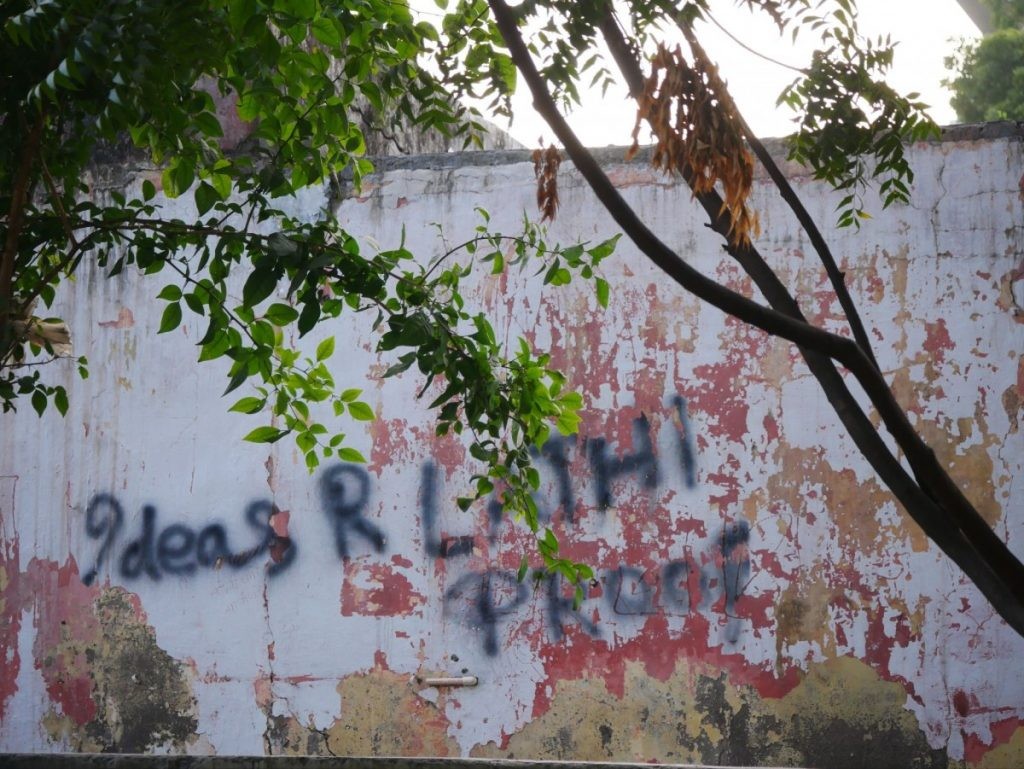
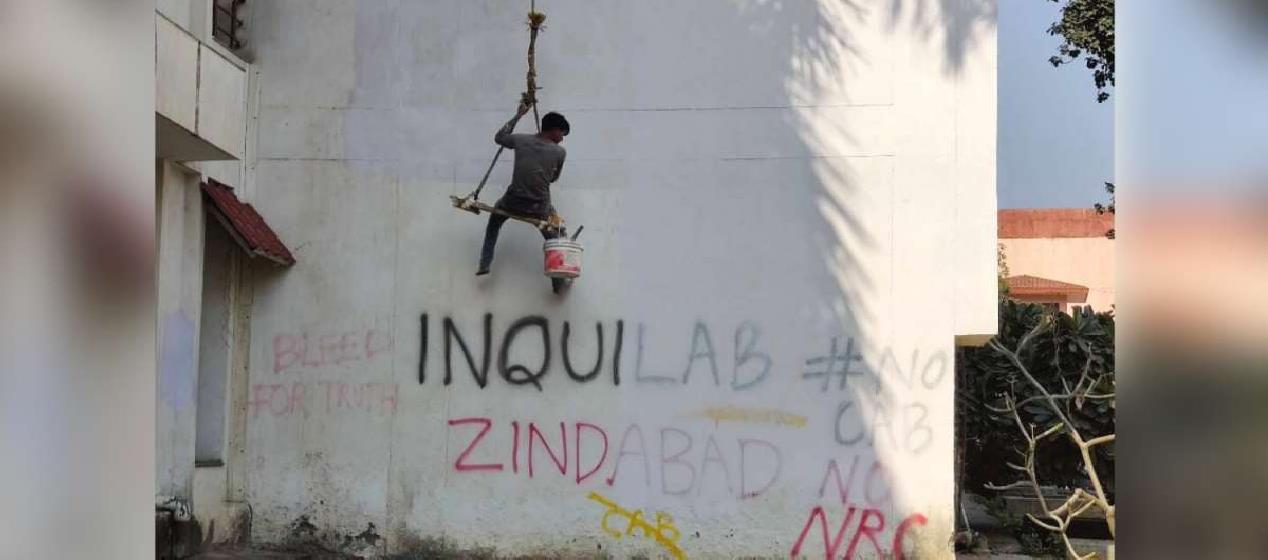
Offensive Graffiti
Graffiti may also be used as an offensive expression. This form of Graffiti may be challenging to identify, as it is mainly removed by the local authority (as councils which have adopted criminalisation strategies also strive to remove Graffiti quickly). Therefore, existing racist Graffiti is mostly more subtle and, at first sight, not easily recognised as “racist”. It can be understood only if one knows the relevant “local code” (social, historical, political, temporal, and spatial), which is seen as heteroclite and thus a ‘unique set of conditions in a cultural context.
For example, a spatial code could be that a specific youth group in an area is engaging heavily in racist activities. So, for residents (who know the local code), Graffiti containing only the name or abbreviation of this gang is a racist expression, reminding the offended people of their severe criminal activity to Gang activities. Also, Graffiti is, in most cases, the herald of more me. A person who does not know these gang activities would be unable to recognise the meaning of this Graffiti. Also, if a tag of this youth group or gang is placed on a building occupied by asylum seekers, its racist character is even more vital.
By making Graffiti less explicit (as adapted to social and legal constraints), these drawings are less likely to be removed but do not lose their threatening and offensive character.
Elsewhere, activists in Russia have used painted caricatures of local officials with their mouths as potholes to show their anger about the poor state of the roads. In Manchester, England a graffitists painted obscene images around potholes, which often resulted in their being repaired within 48 hours.
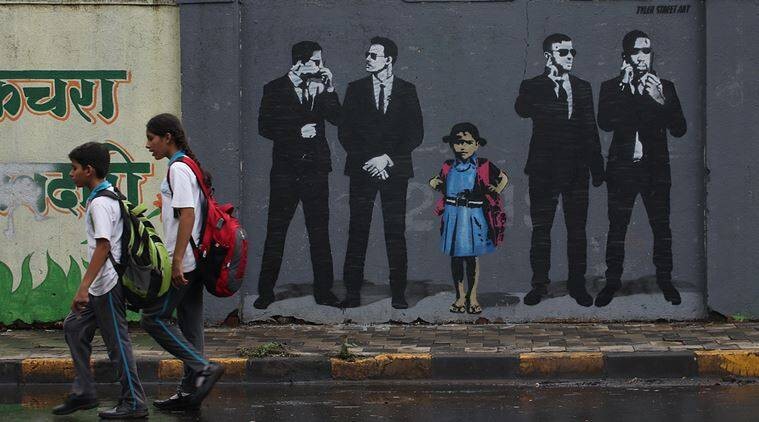
In the early 1980s, the first art galleries to show graffitists to the public were Fashion Moda in the Bronx, New Gallery and Fun Gallery, both in the East Village, Manhattan.
A 2006 exhibition at the Brooklyn Museum displayed Graffiti as an art form that began in New York’s outer boroughs and reached great heights in the early 1980s with the work of Crash, Lee, Daze, Keith Haring, and Jean-Michel Basquiat. It displayed 22 results by New York graffitists, including Crash, Daze, and Lady Pink. In an article about the exhibition in Time Out, curator Charlotta Kotik said she hoped the collection would cause viewers to rethink their assumptions about Graffiti.
From the 1970s onwards, Burhan Dogancay photographed urban walls worldwide; these he then archived as sources of inspiration for his painterly works. Today a project known as “Walls of the World” has grown beyond even his expectations and comprises about 30,000 individual images. It spans 40 years across five continents and 114 countries. In 1982, photographs from this project included a one-person exhibition titled “Les mursmurmurent, ilscrient, ilschantent …” (The walls whisper, shout and sing …) at the Centre Georges Pompidou in Paris.
In Australia, art historians have judged some local graffiti of sufficient creative merit to rank them firmly within the arts. Oxford University Press’s art history text Australian Painting 1788– 2000 concludes with a lengthy discussion of Graffiti’s essential place within contemporary visual culture, including the work of several Australian practitioners.
Between March and April 2009, 150 artists exhibited 300 graffiti pieces at the Grand Palais in Paris. 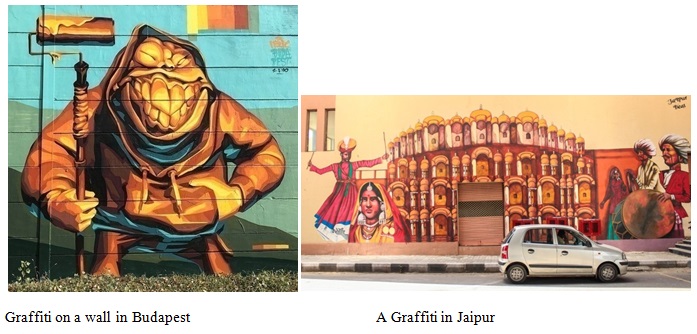 Government Responses to Graffiti
Government Responses to Graffiti
In China, Mao Zedong, in the 1920s, used revolutionary slogans and paintings in public places to galvanise the country’s communist revolution. Based on different national conditions, many people believe that China’s attitude towards Graffiti is fierce, but in fact, according to Lance Crayon in his film Spray Paint Beijing: Graffiti in the Capital of China, Graffiti is generally accepted in Beijing, with artists not seeing much police interference. Political and religiously sensitive Graffiti, however, is not allowed.
In Hong Kong, Tsang Tsou Choi was known as the King of Kowloon for his calligraphy graffiti over many years, in which he claimed ownership of the area. Now some of his work is preserved officially.
In Taiwan, the government has made some concessions to graffitists. Since 2005 they have been allowed to freely display their work along some sections of riverside retaining walls in designated “Graffiti Zones”.56 From 2007, Taipei’s Department of cultural affairs also began permitting Graffiti on fences around major public construction sites. Department head Yong-ping Lee stated, “We will promote graffiti starting with the public sector, and then later in the private sector too. It’s our goal to beautify the city with graffiti”. The government later helped organise a graffiti contest in Ximending, a famous shopping district. Graffitists caught working outside these designated areas still face fines of up to NT$6,000 under a Department of environmental protection regulation. However, Taiwanese authorities can be relatively lenient, with one veteran police officer stating anonymously, “Unless someone complains about vandalism, we won’t get involved. We don’t go after it proactively.”
In 1993, after several expensive cars in Singapore were spray-painted, the police arrested a student from the Singapore American School, Michael P. Fay, who questioned him and charged him with vandalism. Fay pleaded guilty to vandalising a car in addition to stealing road signs. Under the 1966 Vandalism Act of Singapore, initially passed to curb the spread of communist Graffiti in Singapore, the court sentenced him to four months in jail, a fine of S$3,500 (US$2,233), and a caning. The New York Times ran several editorials and op-eds that condemned the punishment and called on the American public to flood the Singaporean embassy with protests. Although the Singapore government received many calls for compassion, Fay’s caning took place in Singapore on 5 May 1994. Fay had initially received a sentence of six strokes of the cane, but the president of Singapore, Ong Teng Cheong, agreed to reduce his caning sentence to four lashes.
In South Korea, Park Jung-soo was fined two million South Korean won by the Seoul Central District Court for spray-painting a rat on posters of the G-20 Summit a few days before the event in November 2011. Park alleged that the initial “G-20” sounds like the Korean word for “rat”, but Korean government prosecutors alleged that Park was making a derogatory statement about the president of South Korea, Lee Myung-bak, the host of the summit. This case led to public outcry and debate on the lack of government tolerance and support for freedom of expression. The court ruled that the painting, “an ominous creature like a rat,” amounts to “an organised criminal activity”. It upheld the fine while denying the prosecution’s request for imprisonment for Park.
Note
*”Graffito”. Oxford English Dictionary. Vol. 2. Oxford University Press. 2006.
*”Why Gang Graffiti Is Dangerous—Los Angeles Police Department”. www.lapdonline.org. Archived from the original on 20 February 2018. Retrieved 19 February 2018.
*Caves, R. W. (2004). Encyclopedia of the City. Routledge. p. 315.
*The Italian singular form “graffito” is so rare in English (except in specialist texts on archaeology) that it is not even recorded or mentioned in some dictionaries, for example, the Longman Dictionary of Contemporary English and the Cambridge Advanced Learner’s Dictionary.
*American Heritage Dictionary
*Grant, Alison (1983). North Devon Pottery: The Seventeenth Century. University of Exeter Press. pp. 1–2.*
“How Old Is Graffiti?”. Wonderopolis. Retrieved 24 January 2017.
*dan. “Ancient Arabia: Languages and Cultures—Safaitic Database Online”. krc2.orient.ox.ac.uk. Archived from the original on 20 February 2018. Retrieved 19 February 2018.
*dan. “The Online Corpus of the Inscriptions of Ancient North Arabia—Safaitic”. krc.orient.ox.ac.uk. Archived from the original on 20
February 2018. Retrieved 19 February 2018.
*”Tacherons on Romanesque churches”
* British Archaeology, June 1999
*”Underground Rome”. The Atlantic Monthly. April 1997.
*”Independence Rock—California National Historic Trail (National Park Service)”. National Park Service. Retrieved 18 January 2018.
*”Art Crimes”. Jinx Magazine. Archived from the original on 14 October 2014.
*Shanks, Michael (1996). Classical Archaeology of Greece: Experiences of the Discipline. London, New York: Routledge. p. 76. ISBN 978- 0-415-08521-2
* Edwards, Paul (10 February 2015). “Is Graffiti An Element Of Hip-Hop? (book excerpt)”. The Concise Guide to Hip-Hop Music.
Retrieved 23 August 2018.
* Daniel, Bill (22 July 2010). “Who Is Bozo Texino?”. Retrieved 23 August 2018.
* Daniel, Bill (2005). “Who Is Bozo Texino?”. Who Is Bozo Texino? The Secret History of Hobo Graffiti. Retrieved 23 August 2018.
*Reagan, Geoffrey (1992). Military Anecdotes (1992). Guinness Publishing. p. 33. ISBN 978-0-85112-519-0.
*”Words From a War”. The New York Times. 14 August 1985. Retrieved 2 January 2017.
* Russell, Ross. Bird Lives!: The High Life And Hard Times Of Charlie (yardbird) Parker. Da Capo Press.
*Labonte, Paul. All-City: The book about taking space. Toronto. E.C.W. Press. 2003
*David Hershkovits, “London Rocks, Paris Burns and the B-Boys Break a Leg”, Sunday News Magazine, 3 April 1983.
*Ellis, Rennie (1985). The All New Australian Graffiti. Sun Books, Melbourne. ISBN 978-0-7251-0484-9.
*Niccolai, James (19 April 2001). “I.B.M.’s graffiti ads run afoul of city officials”. CNN. Archived from the original on 4 October 2006.
Retrieved 11 October 2006.
*”Sony Draws Ire With PSP Graffiti”. Wired. 5 December 2005. Retrieved 8 April 2008.
*”Sony Draws Ire With PSP Graffiti”. Wired. 5 December 2005. Retrieved 8 April 2008.
*Ganz, Nicolas (2004). Graffiti World. New York. Abrams.
*”Gullu Daley, Ajax Watson and Jestina Sharpe depicted in St Paul’s street art”. B.B.C. News. 2022-01-18. Retrieved 2022-01-19.
*Karen Kurczynski (2008). Expression as vandalism: Asger Jorn’s “Modifications”. The University of Chicago Press. p. 293.
*Martin Thiele; Sally Marsden (25 January 2002). “P(A.R.T.) anticipation and Social Change (.doc file)”. Archived from the original (DOC) on 15 June 2005. Retrieved 11 October 2006.
*Banksy (2005). Wall and Piece. New York: Random House UK. ISBN 9781844137862.
*Shaer, Matthew (3 January 2007). “Pixnit Was Here”. The Boston Globe. Retrieved 1 March 2009.
*Tamminen, Jari: Kuka omistaagraffitin? In Voima issue #1/2021, p. 40.
*”Crass Discography (Christ’s reality asylum)”. Southern Records. Archived from the original on 12 September 2006. Retrieved 11 October 2006.
*SFT: Ny dokumentärrederutgraffitinspunkigarötter Archived 26 January 2009 at the Wayback Machine. Dr Rat died in 1981 of an overdose at 20 and was somewhat of an underground hero.
*Ramsel, Yannick (8 January 2021). “Die Hakenkreuzjägerin”. Der Spiegel.
*Cataneo, Emily (12 April 2018). “The Berliner Who Evaded Arrest”. Off Assignment.
*Ley, David; Roman Cybriwsky (Dec 1974). “Urban Graffiti as Territorial Markers”
* Halsey, M.; Young, A. (2002). “The Meanings of Graffiti and Municipal Administration”. Australian and New Zealand Journal of Criminology. 35 (2): 165–86. doi:10.1375/acri.35.2.165. S2CID 145251151.
*Holquist, M. (1981). “Glossary”. In Bakhtin, M.M. (ed.). The Dialogic Imagination. Austin: University of Texas Press. p. 423.
*Kelling, G.; Coles, C. (1996). Fixing Broken Windows. New York: Martin Kessler Books.
* Barker, M. (1981). The New Racism. London: Junction Books.
*Lynn, Nick; Lea, Susan J. (2005). “‘Racist’ Graffiti: text, context and social comment”. Visual Communication. 4: 39– 63. doi:10.1177/1470357205048935. S2CID 145493422
*diallo, David (2014). “From the Street to Art Galleries: How Graffiti Became a Legitimate Art Form”. Open Edition. Retrieved 26 August 2018.
*Morgan, Tiernan (6 August 2015). “35 Years After Fashion Moda, a Bronx Gallery Revisits the Landmark Space”. Hyperallergic. Retrieved 26 August 2018.
*SAMUELS, TANYANIKA (15 February 2013). “The legacy of Fashion Moda, a shuttered art and performance space, to be spotlighted”. New York Daily News. Retrieved 26 August 2018.
*Smith, Bernard William; Smith, Terry; Heathcote, Christopher (2001). Australian Painting 1788–2000. Oxford University Press.
*”RFI—Graffiti gets into the Grand Palais”. Rfi.fr. Retrieved 29 July 2010.
*Rohter, Larry (30 March 2009). “Toasting Graffiti Artists”. The New York Times. Retrieved 2 April 2010.
*”In pictures: Graffiti artists in Beijing, Graffiti tradition”. BBC NEWS.
*”Beijing’s thriving graffiti culture may surprise you”. Public Radio International. Retrieved 24 April 2019.
*Mo, Yan-chih (13 August 2007). “FEATURE: Taipei’s graffiti artists strive for greater acceptance”. Taipei Times. Retrieved 16 January 2011.
*”Taipei targets graffiti”. Taipei Times. 8 June 2009. Retrieved 16 January 2011.
*Jennings, Ralph (25 September 2008). “Taiwan graffiti artist colours in the legal grey area”. Reuters. Retrieved 16 January 2011.

